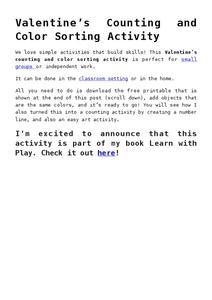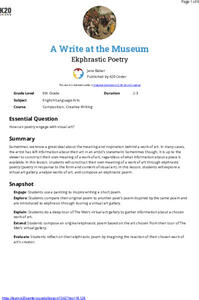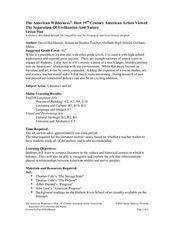Teaching 2 and 3 Year Olds
Valentine’s Counting and Color Sorting Activity
Reinforce the concept of one-to-one correspondence with a Valentine's Day-themed counting and color sorting activity. Scholars sort foam hearts by color—red, orange, yellow, green, blue, and purple—then count and place them on a number...
Curated OER
Tiles, Blocks, Sapphires & Gold: Designing a Treasure Map
Young cartographers in groups hide treasure at school and then create a map to find it using pattern blocks and tiles. They make paintings with clues to create a visual representation of the location of their treasure. Groups present...
Curated OER
Lesson: Patience, Practice and Persistence
First the class analyzes the painting, Rodeo-Pickup Man by Frank Mechau, then they get to work. They explore the painting through verbal descriptions, focusing on vivid language to describe detail. They then compose a written piece using...
Academy of American Poets
Teach This Poem: "The Tradition" by Jericho Brown
To begin this lesson, class members examine Antonius Hockelmann's painting "Tree Flowers II," record elements of the painting that they notice, and share their observations with a partner. Next, pupils do a close reading of Jericho...
Curated OER
Lesson Plan: How Coyote Came to Shuffle Off to Buffalo
Creative kids read, discuss, play-act, and sketch to examine the cultural significance of Old Man Coyote. They listen to several stories involving Coyote, analyze the Harry Fonseca painting Shuffle Off to Buffalo, and write Coyote...
Curated OER
Lesson: One of These Things is Not Like the Other
Kids kick of the lesson by comparing and contrasting the focus painting to other similar paintings of Native American women. They then compare their own personal portraits (photographs) in a similar way. They use the differences in each...
Curated OER
Lesson: Who Are You Supposed to Be?
A new way to connect visual art and creative writing is on the horizon. Kids first identify the characters in the painting Rabbit Hunt, then write narrative from the perspective of one of the characters in the painting. They combine...
Teach Engineering
Consult for the Conductive Circuit Card Company
Light up someone's day with conductive greeting cards. Scholars design and create greeting cards that include LED lights. Rather than use copper tape, they apply conductive paint or copper paint to create the necessary electric circuits.
K20 LEARN
A Write At The Museum: Ekphrastic Poetry
Which came first—the painting or the poem? For this case, it is the painting. Scholars closely examine a work of art and then craft an ekphrastic poem in response. A carefully scaffolded nine-page plan leads young poets through the process.
Curated OER
The American Wilderness? How 19th Century American Artists Viewed the Separation of Civilization and Nature
The attitudes of European settlers toward the American wilderness, as reflected in art and literature, is the focus of this resource packet designed for teachers. Included in the unit overview you will find lists or paintings and works...
Curated OER
Lesson Plan: Sensory Exploration
Using their keen eyes and ears, learners build story observation skills which they will use to create sensory detail in their art. They note all of the things they observed on a walk, categorize them by sense, and then use the same skill...
Curated OER
Lesson: From Time to Time
A portrait The Radcliffe Family circa 1742 is inspiration for creative writing and empathetic reasoning. Your class discusses the period in which the piece was painted, then imagines what life was like for one of the people seen in the...
Huntington Library
Everyday Life - Exploring the California Missions
Young scholars relive history as they examine primary sources that document everyday life in the California missions. During a class viewing of the included slideshow presentation, children analyze documents, paintings, and drawings in...
Alabama Learning Exchange
Edgar Allan Poe's Journey Through Life and Literature
How was Edgar Allan Poe able to create "intriguing, memorable, and lasting literature"? To answer this question, learners analyze the syntax, diction, and characterizations in Poe's poems and short stories and compare the impact of these...
University of Minnesota
Beautiful Brain: Do You See What I See?
Can art play tricks on your eyes, and can a still painting really appear to vibrate? The second lesson in a four-part series discusses the way our beautiful brains translate visual images. It highlights the style of optical art and...
PBS
Benjamin Franklin: Writer, Inventor, and Founding Father
Imagine being a writer, inventor, businessman, and the founding father of an entire nation! Pupils analyze the life and activities of Benjamin Franklin. Primary documents, videos, and paintings open up the world of Franklin to young...
University of Pennsylvania
Using Comic Strips to Teach Multiple Perspectives
Scholars view comics from two different perspectives; one paints the Alfred Dreyfus as innocent, while the other portrays the exact opposite. They solve the mystery of what happened by analyzing the source, working in groups, and...
Little Stones
How Can Poetry Make People Think and Care?
Can beautiful words change the world? Literary scholars discover how to paint their visions of change using poetry in a series of three workshops. Each independent topic gives participants a chance to examine their feelings about...
WE Charity
High School–Module 1: Sustainable Innovation
What does it mean to have an innovative mindset? Pupils think outside the box with the first of five lessons from the WE Are Innovators—High School Modules set. Scholars read articles and watch videos about sustainable innovation, such...
Reed Novel Studies
The Voyage Of The Dawn Treader: Novel Study
A painting is worth a thousand words—in a different world! Lucy and Edmund sail away into Narnia using a picture of a ship at sea. The story tells of their adventures and the islands they visit. Scholars work through activities about the...
Council for the Curriculum, Examinations and Assessment
Victorian Historians
Take the class back in time to the Victorian Era! The resource provides a plethora of activities that create experiences for scholars in class. Some activities include a fun fair, viewing the starry-night painting, and even experiencing...
Radford University
Down on Sue's Farm
When would a farmer use math? Class members work through five tasks on a farm that require knowledge of surface area, volume, and determining regression equations. The challenges range from figuring out the amount of paint to buy,...
Simon & Schuster
Curriculum Guide to: Pride and Prejudice by Jane Austen
An 18-page curriculum guide for Jane Austen's Pride and Prejudice consists of five lessons. The first plan asks readers to compare the manners, social behaviors, and class issues in Austen's novel to today's. Next, pupils examine a...
Center for History Education
Guatemalan Coup of 1954: How Did the Cold War Influence American Foreign Policy Decisions?
Was it all about the bananas—or the fear of a communist threat? Young historians use a history lab to examine documents from the American-led 1954 Guatemalan coup. Using graphics, government documents, and speeches, they examine the...
Other popular searches
- Monochromatic Painting
- Renaissance Paintings
- Dot Paintings
- Finger Painting
- Painting Computer
- Bark Painting
- Medieval Paintings
- Amate Bark Painting
- Oil Painting
- Acrylic Painting
- Painting Composition
- Painting Art

























